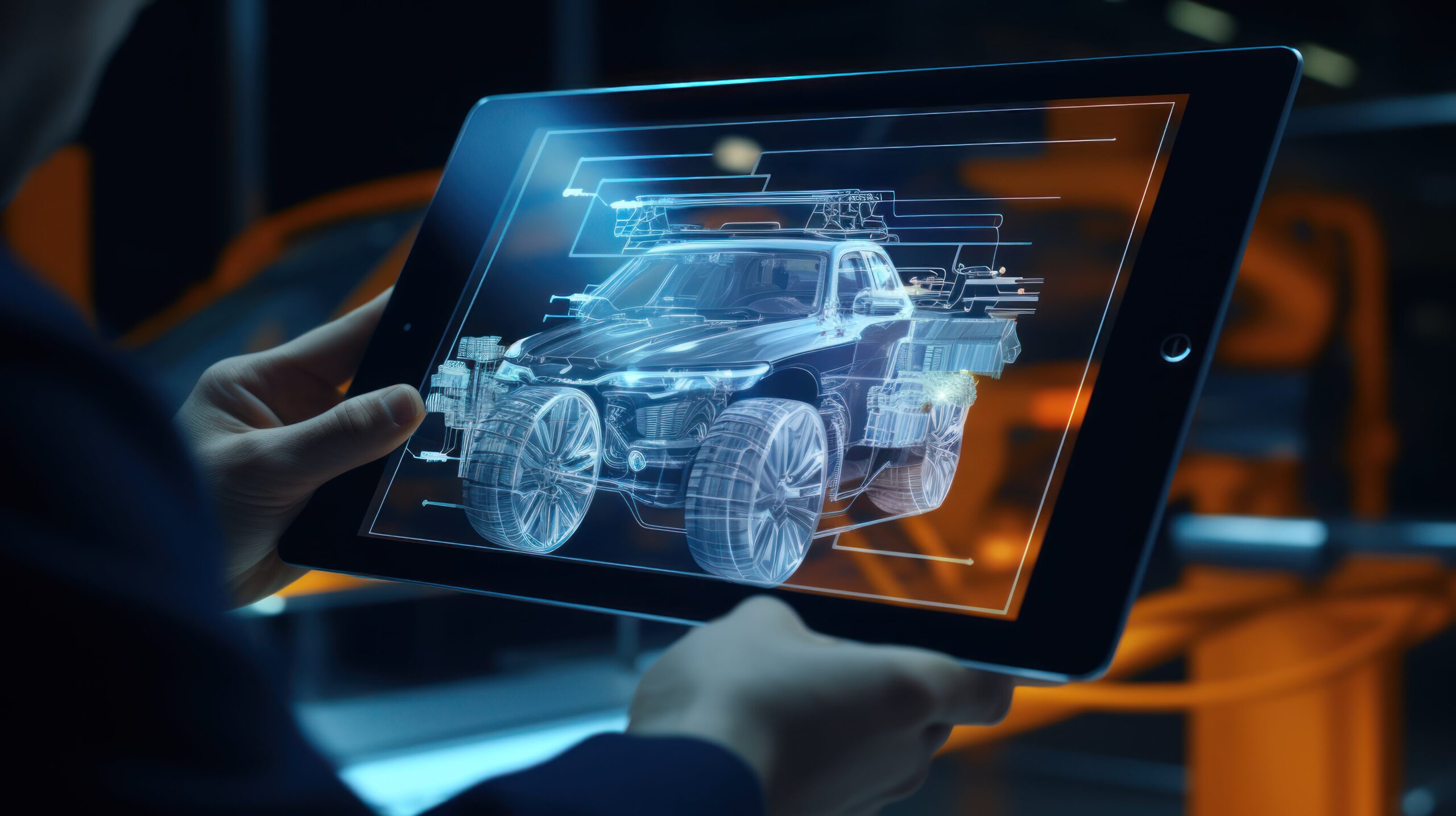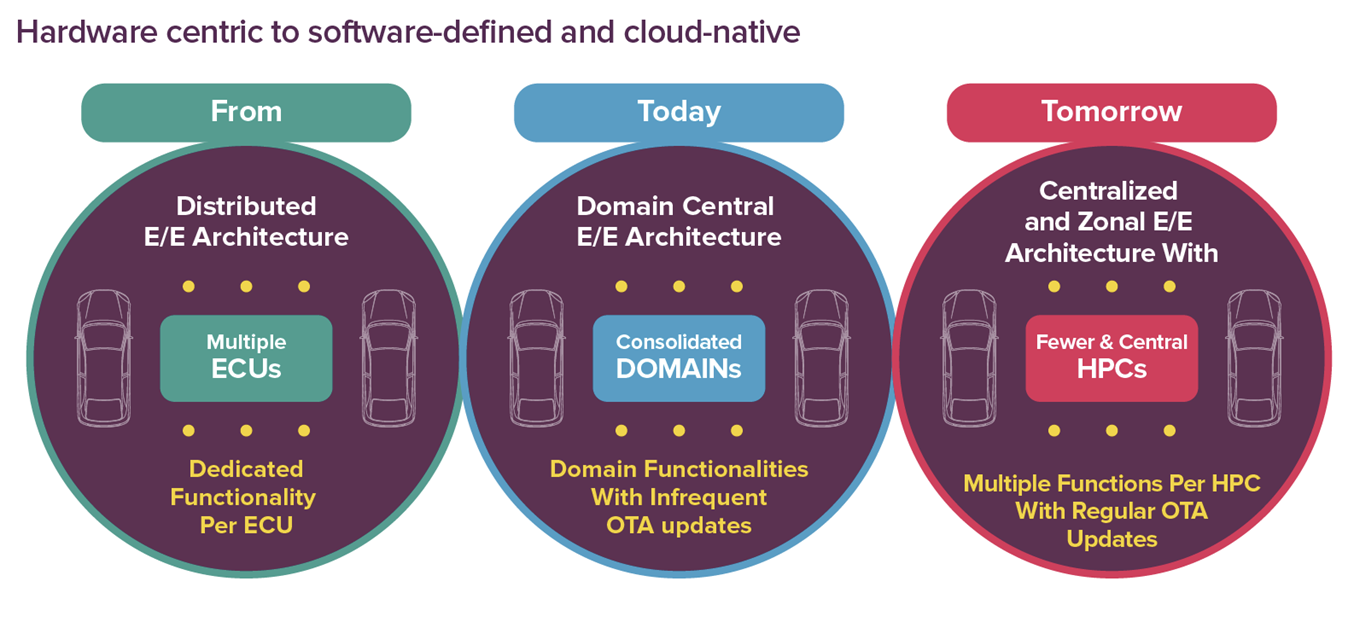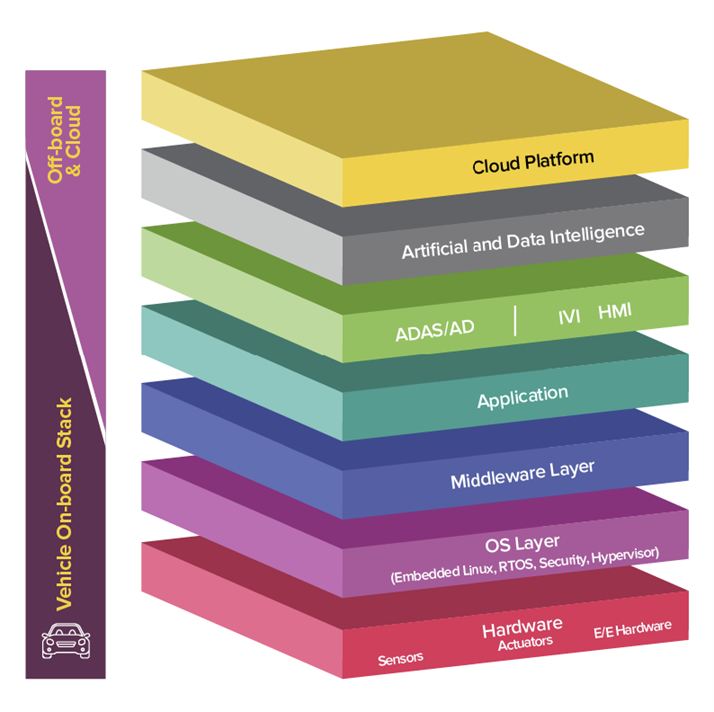Introduction
Over the years, driving has evolved from being a mere mode of transportation to an increasingly immersive and personalized experience, shaped by innovation and shifting consumer expectations. At the heart of this evolution lies the rise of Software Defined Vehicles (SDVs). This shift from traditional hardware-centric designs to software-centric architectures is not merely a technological evolution; it’s a fundamental rethinking of how vehicles are conceived, built, and experienced. In this thought leadership article, we will explore the importance of SDVs, their implications for OEMs (Original Equipment Manufacturers), Tier-1 suppliers, and the entire automotive ecosystem, while also highlighting strategic insights and tactical approaches necessary for successful implementation.
Why Software-Defined Vehicles (SDVs) Are Pioneering the Future of Automotive Innovation

Software Defined Vehicles represent a paradigm shift in automotive design and functionality. Unlike traditional vehicles that rely heavily on mechanical components, SDVs leverage software to manage and enhance vehicle operations. This approach allows for over-the-air (OTA) updates, real-time data processing, and the integration of advanced features such as autonomous driving capabilities and sophisticated driver assistance systems (ADAS) as well as digital cockpit functions. As vehicles evolve into Software-Defined Vehicles with zonal architectures and better upgrades and updateability, the potential for continuous innovation and enhanced user experiences expands dramatically.
- The growing importance of SDVs
The significance of SDVs in the automotive landscape cannot be overstated. The emergence of software-defined vehicles will create over $650 billion in value for the auto industry by 2030, making up 15% to 20% of automotive value. OEM revenues from automotive software and electronics will grow nearly three-fold between now and 2030, from $87 billion to $248 billion, according to a Boston Consulting Group (BCG) analysis1 of SDV growth. As vehicles become more connected and intelligent, consumers increasingly prioritize software-driven features over traditional hardware specifications. This shift necessitates that OEMs and suppliers adapt their strategies to remain competitive.
- How SDVs reshape the automotive industryFor OEMs, SDVs reduce dependence on complex hardware configurations, replacing them with consolidated, software-driven systems that lower production costs and simplify logistics. For Tier-1 suppliers, SDVs mean transitioning from component-focused roles to software-centric partnerships, allowing faster response to OEM needs. Ultimately, SDVs enable the entire automotive ecosystem to focus on innovation, with an emphasis on reducing lead times, accelerating time to market, and delivering superior customer experiences.
- Core attributes of SDVsAccording to the Eclipse Software-Defined Vehicle initiative, an SDV is characterized by decoupling hardware and software components, allowing each to evolve independently. This creates a flexible platform capable of supporting Over-the-Air (OTA) updates, integrating modular software, and enabling custom features tailored to user preferences.In SDVs, high-performance central computers reduce multiple independent Electronic Control Units (ECUs) to central high-performance cluster units (HPCs), supporting various applications — from advanced driver-assistance systems (ADAS) to digital cockpits and infotainment. The centralized architecture empowers OEMs to introduce features like real-time data processing, AI-enhanced driver assistance, and automated driving capabilities across their fleet.
How Open Architecture and Open Source Drive SDV Development
The shift to open architecture and open-source solutions is redefining how the automotive industry builds Software-Defined Vehicles (SDVs). OEMs are leveraging open-source software (OSS) based OS, middleware, and cloud-native technologies to enhance in-house software capabilities, reducing dependency on Tier-1 suppliers and gaining greater control over vehicle software. Linux-based systems for infotainment, ADAS, and autonomous driving, along with virtualization and containerization, enable modular, scalable platforms that support fast updates and customization.
Open architecture also promotes a collaborative ecosystem, allowing code reuse and enabling OEMs to innovate faster, improve efficiency, and cut costs tied to proprietary systems. With open-source frameworks aligning to cloud-native methodologies, SDV development accelerates while ensuring flexibility and interoperability across the industry. This approach not only provides a competitive edge but also positions the automotive sector for a future centered on software-driven growth.
- Next-gen architecture for adaptable, secure, and connected SDVsSDVs are revolutionizing the automotive industry through innovative architectural designs and advanced software capabilities. This shift goes beyond adding features, fundamentally redefining how vehicles are developed, maintained, and experienced.SDV architecture enhances adaptability in design flexibility, personalization, and sustainability. Through zonal architectures, over-the-air updates, enhanced connectivity, and optimized performance, OEMs can deliver vehicles that meet current consumer demands and seamlessly adapt to future needs.
- The evolution of vehicle architecturesAutomotive electrical/electronic (E/E) architectures are evolving rapidly. The industry has moved from distributed architectures with multiple ECUs dedicated to specific functions to domain-based configurations where centralized processors manage multiple functions. The next frontier is zonal architectures, where powerful central computers consolidate and streamline vehicle functions.

These architectural changes align with cloud-native development approaches, where software modules are abstracted from hardware, supporting agile deployment and robust scalability. OEMs and suppliers benefit from reduced production complexity, streamlined testing, and modular flexibility, which is essential in an era defined by rapid software evolution.
- Zonal architecture for future-ready SDVsZonal architecture transforms SDVs through reduced complexity, centralized control, and enhanced connectivity and reliability. Organizing vehicle functions into modular zones managed by high-performance computing units enables OEMs to design flexible, scalable vehicles that meet current demands and adapt to future needs. This approach streamlines vehicle electronics, supports faster, secure over-the-air updates, and allows real-time decision-making.Integrating Zonal Control Units (ZCUs) brings challenges, as manufacturers must address complexity, latency, safety, and upgrade flexibility—requiring specialized expertise, advanced testing, and strong cybersecurity measures.Zonal architectures further improve Vehicle-to-Everything (V2X) communication, seamlessly connecting vehicles with infrastructure, other vehicles, and pedestrians. With control functions distributed across zones, ZCUs provide redundancy, improved diagnostics, and adaptability, driving safer, more efficient, and future-ready vehicles in the software-defined era.
- Bridging the Onboard and Offboard Components of SDVsSDVs rely on smooth on-board (vehicle) and off-board (Cloud) integration, where vehicle data flows to the cloud for processing, analysis, and decision-making. This data-driven approach supports a feedback loop for continuous improvement, enhanced performance, and personalized services.The connection between onboard systems and cloud infrastructure creates a “vehicle-to-cloud” framework where data on driving behavior, environmental conditions, and vehicle health can be analyzed to optimize functions, predict maintenance needs, and deploy new features. This connection also enables cloud-native software packaging and smooth deployment into vehicles through over-the-air updates. The cloud supports both the development and testing of vehicle-related software functions and the operational connectivity and backend services.

Onboard components, including hardware, operating systems, middleware, and applications, enable real-time functionalities such as ADAS, infotainment, and digital cockpits. High-performance computing, zonal architectures, middleware frameworks like Autosar, and OTA updates ensure performance, safety, and personalization while maintaining cybersecurity.
Offboard cloud infrastructure supports data-intensive tasks like AI analytics, fleet management, and virtual testing. Cloud-native development and DevOps practices (CI/CD) enable continuous software updates and “vehicle-to-cloud” communication. Together, these components form a dynamic framework that allows OEMs and Tier-1 suppliers to create scalable, adaptive SDVs, driving innovation and efficiency across the automotive ecosystem.
- The role of software platforms and middlewareA robust software platform with a reliable operating system and middleware is vital for SDV functionality. Open-source solutions like Linux are becoming popular in the automotive industry for their adaptability and developer support even in the future for functional safety domains. Middleware enables data exchange across applications, supporting real-time decision-making and enabling various SDV applications, including infotainment/digital cockpit, navigation, and ADAS. Also, there is a trend to use more open-source components on the middleware layer and corresponding API layer in the interface to the applications.
- Testing and validation in the SDV lifecycleTesting in the SDV lifecycle goes beyond traditional automotive validation. Software testing involves continuous validation and automation to ensure functional safety and reliability, even as new features are deployed OTA. Advanced simulation, digital twins, and virtual ECU environments allow for early testing of features and accelerate the shift-left approach, where testing is integrated into early development stages.
Evolution from ‘non-connected’ towards ‘immersive SDVs’:
- Non-connected software-enabled carsSoftware enhances the user experience but lacks real-time connectivity for updates.
- OEM focus: Implement cost-effective solutions for parts, maintenance, and updates with minimal connectivity.
- Key OEM challenges: Create basic software update workarounds that do not rely on connectivity.
- Connected carEnables real-time data updates for features like traffic alerts and remote control via mobile apps.
- OEM focus: Establish and maintain car connectivity, build initial cloud infrastructure, and manage mobile service provider partnerships.
- Key OEM challenges: Ensure reliable connectivity and cover limitations in service provider support across regions.
- Smart carSupports over-the-air (OTA) updates for bug fixes and performance improvements; introduces basic in-vehicle app stores.
- OEM focus: Expand OTA capabilities and establish a digital service ecosystem.
- Key OEM challenges: Address hardware limitations, manage fragmented software from multiple suppliers, and balance software needs within restricted hardware setups.
- Software-Defined Vehicle (SDV)Offers ongoing UI/UX improvements and maximum customization; operates with a smartphone-like OS and frequent updates.
- OEM focus: Build SDV-ready organizations, decouple hardware and software development, and control key elements of the tech stack.
- Key OEM challenges: Establish scalable SDV solutions, navigate new business models, and enhance SDV deployment across vehicle portfolios.
- Immersive Software-Defined VehicleIntegrates into users’ lives through enhanced interfaces, cross-domain applications, and multi-sensory interactions.
- OEM focus: Enable higher levels of automation, develop cross-domain ecosystems, and expand hardware and interface control.
- Key OEM challenges: Support sustainable third-party business models, adapt SDV ecosystems to local needs, and maintain cross-domain functionality.
The Path to SDV Maturity
The evolution of SDVs mirrors the trajectory of technological transformation in the automotive industry. SDV maturity can be classified into five levels, each representing a significant leap in software integration, vehicle functionality, and ecosystem collaboration. Leaders across the automotive ecosystem must navigate these levels strategically to harness the full potential of SDVs.
At the foundational Level 0, the software serves a supportive role, with static functionality tied to specific hardware systems like Park Distance Control. Progressing to Level 1, vehicles achieve connectivity by linking static software to dynamic IT infrastructures, enabling features like app-based remote controls. Level 2 introduces regular over-the-air updates, enhancing safety and maintenance by fixing bugs and addressing vulnerabilities in delivered vehicles. The transformative journey begins at Level 3, where software becomes dynamic, allowing functionality upgrades without hardware changes, significantly expanding the vehicle’s capabilities.
In Level 4, the decoupling of hardware and software lifecycles enables modular updates across vehicle generations, paving the way for a highly adaptable platform. The pinnacle, Level 5, transforms vehicles into open innovation platforms, enabling third-party developers to create applications and unlock new business models, much like app ecosystems on smartphones. Reaching this stage requires advanced modularity, robust security, and monetization strategies. The journey through SDV maturity redefines automotive design and operations while creating unprecedented opportunities for innovation and revenue generation.
Vehicle edge and SDVs
Vehicle Edge is redefining SDVs by enabling advanced on-board data processing, reducing dependency on constant cloud connectivity. Drawing parallels with software-defined data centers, where cloud-native technologies like Kubernetes separated software from hardware, Vehicle Edge brings real-time decision-making, enhanced autonomy, improved cybersecurity, and OTA capabilities directly into the vehicle. This architecture also supports the deployment of containerized software, ensuring flexibility and efficiency, even in low-connectivity environments.
This shift mirrors the Telco industry’s move to software-defined networks, where edge computing brought cloud-native functionality into network nodes. Similarly, Vehicle Edge allows OEMs and Tier-1s to handle data directly within the vehicle, enabling seamless V2X communication for enhanced safety, personalization, and reliability. For consumers, it means faster updates and tailored features, positioning SDVs at the forefront of the software-defined mobility era and driving advancements in automotive and IoT ecosystems.
Overcoming challenges in the transition to software-defined vehicles
- Technical hurdlesSDVs bring complex technical challenges, primarily around data privacy and cybersecurity. Extensive data collection and real-time connectivity make SDVs vulnerable to cyber threats, demanding robust encryption and continuous monitoring. Meeting cybersecurity standards like ISO/SAE 21434 requires significant expertise. Ensuring compliance with ISO 26262, the Automotive functional safety standard, is critical to addressing risks associated with increasingly software-reliant systems. Integrating SDVs with legacy systems adds complexity, as OEMs must balance old and new technologies using advanced middleware and abstraction layers to avoid costly overhauls.
- Operational and organizational shiftsTransitioning to SDVs requires a shift from long, specification-driven cycles to agile, iterative processes. SDVs benefit from DevOps and CI/CD methodologies, which support rapid updates and shorten time-to-market. Cross-functional alignment across R&D, IT, production, and service is crucial, requiring OEMs to reskill teams, update workflows, and implement digital collaboration tools to synchronize software and hardware efforts.
- Collaboration and standardizationAdvancing SDVs relies on collaboration and industry-wide standards, which lower costs, streamline integration, and speed up innovation. Open-source platforms and open-source-based initiatives, such as Linux Foundation and Eclipse.SDV provides shared frameworks and working practices that allow OEMs and suppliers to focus on unique features while maintaining compatibility. Traditional specification driven standards like Autosar and ASPICE enhance interoperability and ensure component integration across the value chain and are still valuable combined with open-source approaches.
Open-Source Standards and Traditional Frameworks in the SDV Ecosystem
Open-source standards are transforming the SDV ecosystem by offering flexibility, collaboration, and faster innovation compared to traditional closed frameworks like Autosar and ASPICE. Traditional standards define rigid specifications that ensure interoperability but often slow development due to lengthy approval cycles and limited adaptability. In contrast, open-source initiatives, such as those led by the Eclipse Foundation or COVESA, enable real-time collaboration between OEMs, Tier-1s, and tech providers, fostering a shared ecosystem where modularity and code reuse thrive.
For SDVs, this shift empowers developers to iterate rapidly, customize solutions, and implement cloud-native architectures, aligning software lifecycles with the pace of innovation. While Autosar and ASPICE remain essential for critical safety and compliance in areas like functional safety and software quality, the balance of open and closed standards defines a new era of adaptability and competitive differentiation in the SDV ecosystem.
Agile solutions through cross-functional collaboration
To overcome these challenges, OEMs should:
- Adopt agile and CI/CD for rapid, reliable software updates.
- Build cross-functional teams that integrate IT, R&D, and production functions.
- Leverage digital collaboration tools to enhance communication and workflow efficiency.
- Prioritize cybersecurity with security frameworks, data encryption, and real-time threat monitoring.
With these strategies, OEMs can navigate SDV complexities, foster innovation, and build resilient, future-ready vehicles that meet evolving consumer expectations. SDVs represent the next frontier for the automotive industry, and success will hinge on adaptability, collaboration, and continuous innovation.
Building Collaborative Innovation Ecosystems for SDVs
The rise of SDV is transforming the automotive ecosystem, pushing OEMs to move beyond reliance on Tier-1 suppliers. Today, OEMs collaborate directly with tech providers, cloud companies, cybersecurity experts, and agile start-ups, enabling rapid deployment of digital capabilities, real-time updates, and personalized experiences.

In this new model, Tier-1s are evolving from hardware suppliers to software integration partners, while tech companies provide essential data analytics, AI, and machine learning expertise for predictive maintenance and advanced driver assistance. Start-ups add agility, often pioneering cutting-edge features. This broader network is essential for managing SDV complexity and ensuring interoperability across the industry.
- Shifting priorities – From specifications to real-time implementationsSDVs demand a shift from specification-based, long-cycle development to agile, real-time implementation. Open-source initiatives provide modular frameworks, allowing OEMs and suppliers to build upon shared foundations rather than starting from scratch, accelerating innovation while reducing development costs.
- Building a future-ready ecosystem through strategic partnershipsStrategic alliances are essential to SDV success, as no single entity can meet all technical and security demands.
- Tier-1 suppliers play a pivotal role, transitioning from hardware-centric providers to software integration specialists, enabling modular and interoperable solutions.
- Partnerships with hyperscalers (like AWS, Google Cloud, and Microsoft Azure) enable real-time data processing, OTA updates, and diagnostics.
- Technology companies contribute expertise in AI, machine learning, and data analytics, supporting predictive maintenance, autonomous functionalities, and infotainment systems.
- Semiconductor companies, traditionally focused on silicon, are expanding into cloud services, bridging the gap between hardware and software with innovations in edge computing and system-on-chip (SoC) designs.
- Cybersecurity and functional safety partnerships ensure robust data protection, threat monitoring, and compliance with global standards like ISO 26262 and ISO/SAE 21434. Assessors, consultancies, system integrators, and software product companies play a vital role in fulfilling these requirements.
This cross-industry collaborative ecosystem, underpinned by open-source initiatives, is building a resilient foundation for connected and autonomous mobility.
A unified path to automotive excellence in the software-defined era
SDVs are shaping the future of the automotive industry, promising transformative benefits for OEMs, Tier-1s, and the broader ecosystem. As vehicles evolve into software-centric platforms, the industry must embrace agile development, open-source collaboration, and advanced data analytics to unlock the full potential of SDVs. This journey requires a collaborative approach, where traditional boundaries dissolve, giving way to a more interconnected and innovation-driven ecosystem.
Quest Global is committed to supporting this transition, empowering automotive leaders to innovate, adapt, and excel in a rapidly changing environment. Together, we can pave the way to a smarter, safer, and more connected automotive future, where SDVs redefine what’s possible on the road and beyond.
Why global automotive leaders choose Quest Global
- Trusted & strategic SDV partner: Deep collaboration with OEMs and Tier-1s, from integration to testing, delivering future-ready solutions.
- End-to-end expertise: Full SDV lifecycle support, including on-board architecture, cloud integration, OTA updates and smooth SDV development and integration into existing E/E architectures.
- Leaders in standards & ecosystem: Driving SDV standardization and ecosystem integration with edge computing and data-driven insights.
- Innovation-driven & agile: Agile solutions that empower automotive leaders to adapt quickly and meet industry demands.
- Global scalability with local expertise: Best-cost country sourcing and tailored local-global solutions.
- Expertise in both Vehicle Onboard and Vehicle Offboard domains
Source:
- Rewriting the Rules of Software-Defined Vehicle, BCG, SEP 2023
- https://sdv.eclipse.org/

